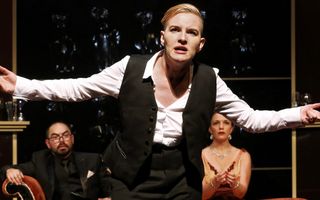 Listen
Listen
Richard III is believed to have been written no later than 1592, as it is said to have influenced the playwright Christopher Marlowe (Edward II), who died in 1593.
The first recorded performance was not until 1633 for King Charles I and Queen Henrietta, in honour of the Queen’s birthday. However, we know from contemporary anecdotes, and the vast number of publications, that the play was hugely popular in its day and performed often. Shakespeare wrote the role of Richard for one of his leading actors, Richard Burbage, whose known skills in verse speaking and physicality would have no doubt done the role much justice.
Richard III is grouped in the First Folio with the histories and completes Shakespeare’s first tetralogy with Henry VI (Parts 1 – 3). It was first published by Andrew Wise in 1597 in quarto form, followed by five other quarto versions before it took its place as the longest play in the First Folio publication in 1623.
The principal source of information available to Shakespeare about Richard III was Sir Thomas More’s History of King Richard III and the chronicle histories of Edward Hall and Raphael Holinshed. Many believe the style of the play is artistically influenced by the Roman dramatist Seneca as it is just as performative and presentational as his tragedies, presenting very little on-stage violence. It is also believed that Shakespeare could have presented Richard III to his audiences as a historical allegory for a contemporary villain, Robert Cecil, Queen Elizabeth’s most influential advisor (whom she called her “Little imp”). Cecil was in favour of a Protestant succession, and had a reputation for deception. Motely’s History of the Netherlands (1888) describes Robert Cecil’s 1588 appearance as, “A slight, crooked, hump-backed young gentleman, dwarfish in stature,” and his character to be one of “massive dissimulation”.
Peter Ackroyd argues that Shakespeare transcended his sources by not only combining their works in ‘fresh and unexpected ways’, but by reinventing the paths of human consciousness. In Richard III, Shakespeare creates a melting pot of formal rhetoric, melodrama, comedy, prophecy and sexuality, and all at a cracking pace. It is in this play that Shakespeare began to take true artistic control; he took liberties with historical accuracy and, for the first time, allowed a central character to dominate the story. Shakespeare’s portrait of Richard has endured over time and is often criticised by groups such as The Richard III Society, for being Tudor propaganda that disables historical accuracy. However, it is still one of the most beloved, and performed of Shakespeare’s plays.
A 1699 adaptation of the play by Colley Cibber, using only a quarter of Shakespeare’s text, dominated the English stages for 200 years. This version was simple and omitted several key characters, yet lasted longer in circulation than any other 17th-century adaptation. Shakespeare’s original text regained its rightful place in the 20th century; the most notable portrayals of Richard being Sir Laurance Olivier’s in 1944, Anthony Sher in 1984 and Ian Mckellen’s 1990 production set in an alternate-reality fascist Britain. The 21st century has seen this coveted role performed by female actors, and Shakespeare’s Globe in London presented an all-female production in 2003 starring Kathryn Hunter as Richard.
In 2012 Richard III’s body was discovered under the Leicester Cathedral carpark as part of a collaboration between Al Pacino’s Looking for Richard Project and The Richard III Society, allowing for a modern scientific study of his skeletal deformities and more research into this historical figure.




